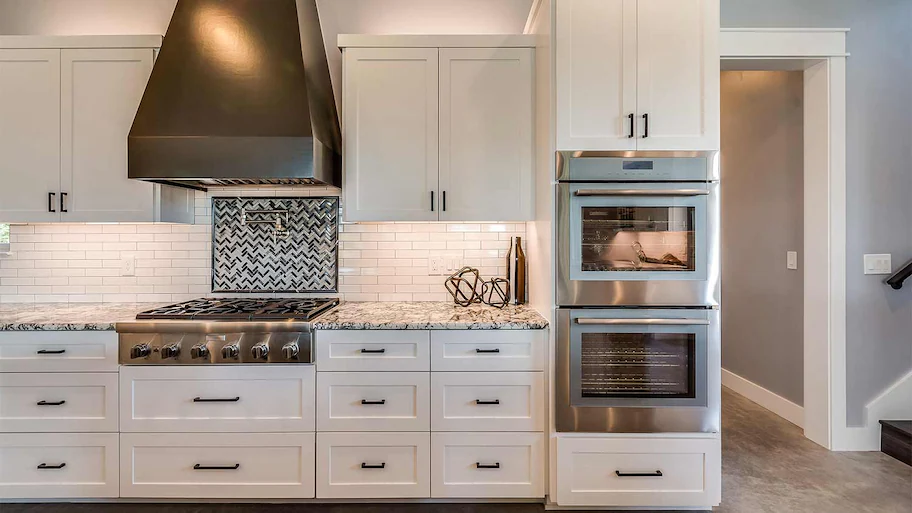If you’re wondering whether or not you need a range hood, you’re not alone. Did you know that a range hood is an appliance made specifically to help your home and family? Check out answers to these key questions to better understand if a range hood is the right choice for you.
Explore range hoods from Whirlpool brand to learn about the different styles and all they have to offer.
What is a range hood?
A range hood, also referred to as a vent hood or kitchen hood, is an appliance commonly installed above ranges or cooktops, designed to capture, filter, or vent out cooking grease and steam from the cooking surface. Equipped with an integrated fan and sometimes supplemented with lights to illuminate the cooktop, range hoods serve an essential function in kitchens.
Range hoods come in various types and sizes to suit different cooking appliances and kitchen configurations. Options include those that vent air outside the home through ducts and ductless range hoods that filter and recirculate air back into the kitchen. Explore the range of hood types and sizes available. For instance, Whirlpool brand offers canopy hoods, downdraft hoods, convertible range hoods, and kitchen hood liners and blowers.
How does a range hood work?
During cooking, the hood operates by drawing in moisture, smoke, and grease with the assistance of a fan. Range hoods with external ventilation expel this air from the home through ductwork, while recirculating range hoods utilize filters to cleanse the air before reintroducing it into the room.
Starting the kitchen hood fan several minutes before cooking begins helps to establish suction, ensuring prompt ventilation. Additionally, running the fan for a few minutes after cooking aids in eliminating any lingering smoke and odor from the air. For those with ductless range hoods that recirculate air, regular cleaning of the filter is necessary. Explore further details regarding the maintenance of over-the-range microwave filters and learn about other components of range hoods.
Do I really need a range hood?
When cooking on any stove, whether gas or electric, grease, food particles, water, and smoke are released into the air. In the short term, this can diminish air quality and fill your home with odors. Over time, these particles can lead to the accumulation of grime throughout your kitchen.
While the necessity of a vent hood may be dictated by local building codes, most individuals can benefit from having one, even if their cooking habits are infrequent or limited to steaming vegetables. However, those who frequently engage in frying, searing meats and proteins, or sautéing have an even greater need for a range hood. It’s advisable to consider models with higher cubic feet-per-minute (CFM) ratings to effectively filter out increased grease and smoke levels.
Are there alternative kitchen ventilation options?
Apart from the conventional range hood positioned above your cooking area, there are alternative options available, including microwave-hood combinations and downdraft ventilation systems that rise from the countertop as needed.
For those seeking enhanced functionality above their range, an Over-the-Range Microwave with built-in recirculating ventilation could be a suitable choice. Limited on space? Consider a low-profile microwave hood combination, offering a two-in-one solution that fits into the same space as an under-cabinet hood.1 Remember to ensure that the size of your venting solution matches the dimensions of your cooktop. Explore further distinctions between range hoods and over-the-range microwaves.
If the look of a hood doesn’t appeal to you or if your cooking surface is installed in an island, downdraft ventilation offers an alternative to maintain clean lines in open-concept kitchens. Ensure that your downdraft vent is adequately rated to accommodate your cooktop. Delve into the various types of range hoods with this comprehensive guide.
What should I consider when buying a range hood?
There is a wide variety of range hoods available, each tailored to suit different cooking habits, kitchen layouts, and preferences. When selecting a range hood, it’s essential to consider your home and lifestyle. Explore these factors to guide your decision:
Power
CFM, or cubic feet-per-minute, measures the airflow capacity of your ventilation system. Gas stoves typically require a higher CFM rating compared to electric ranges.
Sound
While older ventilation systems may have been noisy, newer range hoods often feature low sound level technology, providing quieter operation.
Lighting
Since a hood’s function includes illuminating your cooktop, opt for models with bright lights that offer ample visibility of your entire workspace. Range hoods equipped with LED Task Lighting are a popular choice for this purpose.
Venting
Consider your home’s construction when deciding on ventilation options. In some cases, external venting may not be feasible, leading to the selection of a recirculating hood. Ensure compliance with local and state codes regarding recirculating hood use and adhere to recommended maximum vent length for optimal performance.
Pairing
Match the size of your hood to the dimensions of your cooking surface. Ideally, the pairing should be size for size (e.g., a 30″ hood with a 30″ cooking surface).


